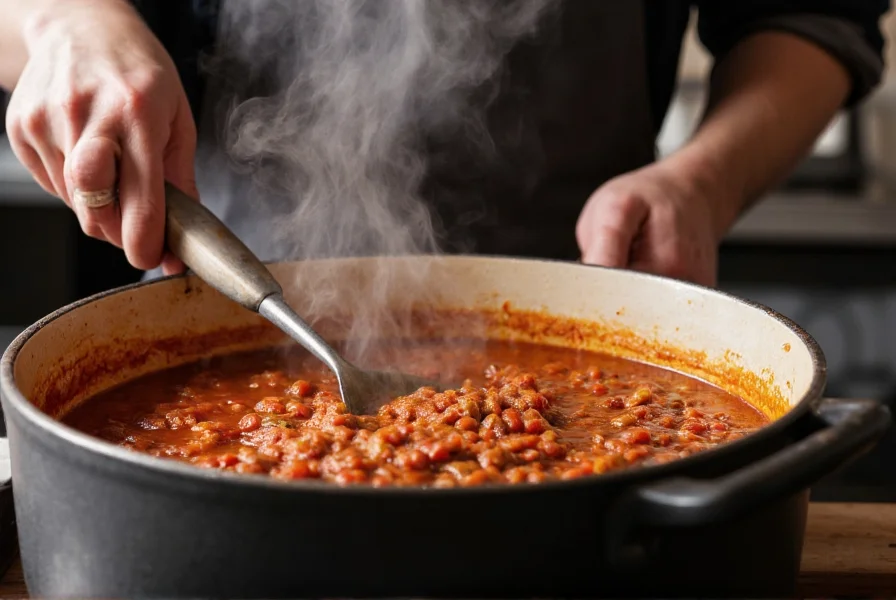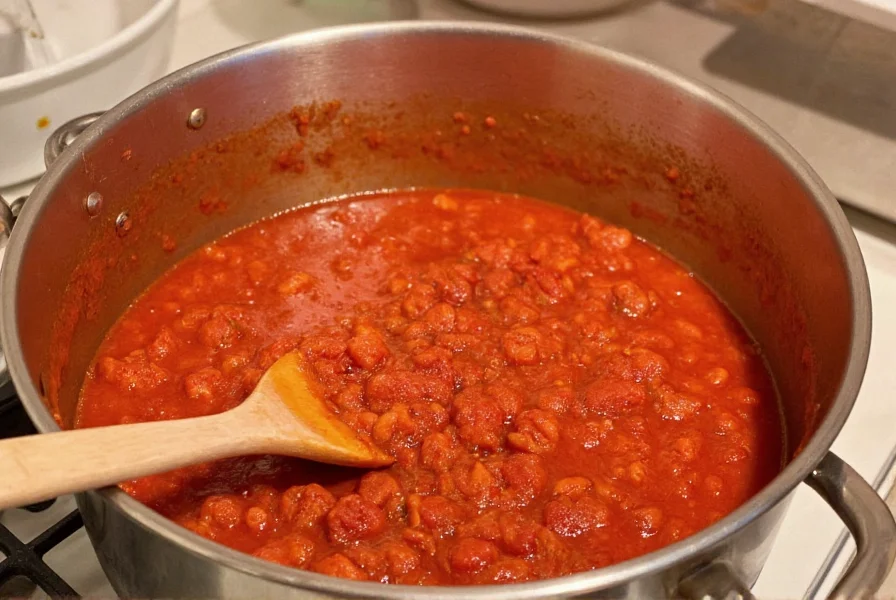Nothing ruins a perfect pot of chili like a watery consistency that lacks that hearty, spoon-coating texture. Whether you're mid-cooking session or reheating leftovers, understanding how to thicken chili properly transforms your dish from disappointing to delectable. This guide reveals professional kitchen techniques that maintain flavor integrity while achieving that ideal thick chili texture every time.
Why Your Chili Might Be Too Thin
Chili often ends up too thin due to excessive liquid from canned tomatoes, beans with too much broth, or insufficient cooking time. The ideal chili should coat the back of a spoon without immediately running off—a consistency achieved through proper liquid reduction and strategic thickening agents. Understanding how to make chili thicker without flour alternatives gives you flexibility based on pantry availability.

Top 7 Methods to Thicken Chili Effectively
Each thickening technique offers unique advantages depending on your timeline, ingredients, and flavor preferences. Master these approaches to fix watery chili regardless of your cooking circumstances.
1. Simmer Uncovered (The Natural Reduction Method)
This simplest approach requires no additional ingredients. Remove the lid and simmer your chili over medium-low heat for 20-30 minutes, stirring occasionally. As water evaporates, the chili naturally thickens while flavors concentrate. This method preserves your original flavor profile perfectly—ideal when learning how to thicken chili without changing taste. For best results, maintain a gentle simmer rather than a rolling boil to prevent scorching.
2. Cornstarch or Flour Slurry (Quick Fix Solution)
Create a slurry by mixing 1 tablespoon cornstarch or all-purpose flour with 2 tablespoons cold water until smooth. Gradually whisk this into your simmering chili and cook for 5 minutes until thickened. This best way to thicken chili quickly works in under 10 minutes with minimal effort. For gluten-free options, arrowroot or tapioca starch work equally well. Remember to always make a slurry first—dumping dry starch directly causes clumping.
| Thickening Method | Time Required | Flavor Impact | Best For |
|---|---|---|---|
| Simmer Uncovered | 20-30 min | None | Maintaining original flavor |
| Cornstarch Slurry | 5-10 min | Neutral | Quick fixes |
| Bean Mash | 5 min | Slight bean enhancement | Bean-based chili |
| Tomato Paste | 10 min | Richer tomato flavor | Tomato-heavy recipes |
3. Mashed Beans (Natural Thickener)
Scoop out 1 cup of beans and chili liquid, mash thoroughly, then return to the pot. The released starches and broken-down beans thicken the entire batch while adding protein. This natural way to thicken chili works especially well for bean-based recipes and adds nutritional value without altering flavor significantly. For optimal results, use a potato masher directly in the pot for partial thickening.
4. Tomato Paste Boost
Stir in 2-3 tablespoons of tomato paste and simmer for 10 minutes. The concentrated solids absorb excess liquid while enhancing umami flavors. This technique serves double duty when addressing how to fix watery chili that also lacks depth. For best results, sauté the paste with onions at the beginning of cooking to caramelize and deepen flavors before adding liquids.
5. Roux Foundation (Classic Technique)
Create a simple roux by cooking 2 tablespoons flour with 2 tablespoons oil or bacon fat over medium heat for 2 minutes until golden. Gradually whisk in ½ cup chili broth, then incorporate this slurry into your main pot. This method provides exceptional thickness with a subtle nutty flavor—perfect when you have time for how to thicken chili properly before serving. The roux prevents flour clumping while adding richness.
6. Masa Harina (Authentic Southwestern Touch)
Mix 2 tablespoons masa harina (corn flour) with ¼ cup warm water, then stir into chili. This traditional thickener adds authentic Southwestern flavor while creating a velvety texture. Understanding how to make chili thicker without flour becomes essential for gluten-free diets, and masa harina delivers excellent results. Allow 5-7 minutes of simmering for full thickening effect.
7. Instant Potato Flakes (Pantry Savior)
Stir in 2-3 tablespoons of instant potato flakes and let sit for 5 minutes. The dehydrated potatoes absorb liquid rapidly without altering flavor—making this the best way to thicken chili quickly when guests arrive unexpectedly. This method works surprisingly well for how to thicken chili without changing flavor profile, especially when other thickeners aren't available.

Preventing Thin Chili: Pro Tips
Avoid watery chili altogether by starting with proper technique. Use minimal liquid when building your chili—canned tomatoes provide sufficient moisture. Opt for no-salt-added beans drained thoroughly. When wondering how long to simmer chili to thicken properly, remember that most recipes require at least 30 minutes uncovered after initial cooking. For meal prep scenarios, slightly under-thicken your chili since it will continue thickening upon cooling and reheating.
Troubleshooting Thickening Issues
If your chili becomes too thick, gradually add broth, beer, or water 1 tablespoon at a time until desired consistency. Over-thickened chili from roux or masa can be rescued more easily than slurry-thickened versions. When using starch-based thickeners, remember they continue working off-heat—remove from burner just before reaching perfect thickness. For flavor balance after thickening, adjust seasonings as concentrated liquids intensify flavors.
Frequently Asked Questions
How can I thicken chili without flour or cornstarch?
Mash beans directly in the pot, use instant potato flakes, add tomato paste, or simmer uncovered to reduce liquid naturally. Masa harina serves as an excellent gluten-free alternative that adds authentic flavor while thickening effectively.
Will simmering chili longer make it thicker?
Yes, simmering uncovered for 20-30 minutes allows liquid to evaporate, naturally thickening your chili without altering flavor. Stir occasionally to prevent sticking, and maintain medium-low heat for gentle reduction rather than rapid boiling.
How much cornstarch should I use to thicken chili?
For a standard 6-cup batch of chili, mix 1 tablespoon cornstarch with 2 tablespoons cold water to create a slurry. Whisk this into simmering chili and cook for 5 minutes. Add additional slurry in small increments if needed, but avoid exceeding 2 tablespoons total to prevent gummy texture.
Can I use baking powder to thicken chili?
No, baking powder won't thicken chili effectively and will create unpleasant flavors and textures. Use proper thickening agents like cornstarch, flour, masa harina, or natural reduction methods instead for optimal results.
Why does my chili get watery when I refrigerate it?
Chili often separates when cooled as starches and proteins release liquid. Simply reheat gently while stirring—most separation resolves during reheating. If still too thin, use one of the quick thickening methods like a small cornstarch slurry or additional simmering time.











 浙公网安备
33010002000092号
浙公网安备
33010002000092号 浙B2-20120091-4
浙B2-20120091-4